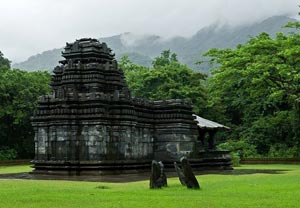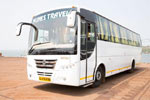Mahadev Temple

The Mahadev temple of Tambdi Surla is the oldest temple of Goa, which is approximately 65 kms from the capital city of Panaji and 12 kms from the border crossing post of Mollem. Tambdi Surla itself is in the midst of a forested area accessible via a 22 kms route from the main town of Valpoi in Sattari Taluka. This temple has survived from the Muslim invasions and Portuguese as it was set next to a stream in the middle of the small clearing, hidden in the dense jungle.
The Tambdi Surla temple dedicated to Lord Shiva has a pillared porch and three stepped entrances. The temple is built in the Hemadpanthi style from the finest weather-resistant grey-black basalt. There are some interesting details about the construction itself which has led to debates about the actual origins of the temple. The temple is built in a place which is quite inaccessible and away from the main settlements of the time. The size of the temple is quite small as compared to the size of the average Goan temple. And finally the top part of the temple has never been completed. It is considered to be the only specimen of Kadamba-Yadava architecture in basalt stone preserved and available in Goa. The temple has been declared as a protected historical monument by the Archaeological Survey of Idia
The temple faces east so that the rays of the rising sun fall on the deity at the crack of dawn. There is a small mandap (pillared hall) and the inner sanctum is surmounted by a three-tired tower which is incomplete or which has been dismantled sometime in the distant past.
Bas-relief figures of Lord Shiva, Lord Vishnu and Lord Brahma, with their respective consorts appear on panels at the sides of the temple. Surprisingly the mandap is covered with a roof of plain grey sloping slabs.
The river Surla flows nearby and can be reached via a flight of stone steps. There is a headless Nandi (bull, Shiva's vehicle) in the centre of the mandap, surrounded by four matching columns. The symbol of the Kadamba kingdom, an elephant trampling a horse is carved on the base of one of the columns.
There is a linga symbol of Lord Shiva mounted on a pedestal inside the inner sanctum and local legend has it that a huge King Cobra is in permanent residence in the dimly lit interior. In February/ March on the festival of Mahashivratri hundreds of devotees assemble here. The area around the temple has soft green grass that dries up in summer but is rejuvenated every monsoon.




